Regionale 23
Homes
27.11.2022 —
8.1.2023
The concept of home has become more fragile. It has long since ceased to simply be the place where you are born and grow up, surrounded by friends and family; where the language of the family home is also spoken in the streets and at school. A place that is synonymous with belonging, security. People often move for study or for work, but—unfortunately and increasingly—crises, fear and danger also cause or even force many to leave their own four walls or home behind.
The artists invited to this year's Regionale at Kunsthaus Baselland all live and work in the region, in France, Germany or Switzerland - but their home is more. They come from Ukraine and have fled to Basel from Russia's war of aggression. They come from different cities and regions of Switzerland, Germany, France, Catalonia, Peru, Argentina, Eritrea etc. to study, live and work as artists in the region. They have spent extended periods of time in places like South Africa on scholarships to work and experience the country. The region we are in, called the tri-border area, unites much more than three countries, because the people who live here for shorter or longer periods of time and enrich us come from all over the world - voluntarily or for political reasons.
What does homeland mean today, when many of us have left for new places or countries to make a new home? Why do we use the word homes so rarely, when it is what would correspond to many of us? Thus, the exhibition shows precisely these circumstances of our here and now; it addresses in different ways ideas or constructs around places of coexistence, of origin, of temporary residence, of emotional attachment - but at the same time also reflects on those that they had to leave behind. Moments of being on the move, whether voluntarily and involuntarily, are also thematized here. With their works, the invited artists pose the decisive and at the same time urgent question that needs clarifying today: How do we want to live in the future? How do we want to shape the future together? And not least: What will it take for us to bring about change - in society, culture, politics, nature - so that we can live together with respect and openness in all our differences and diversity? (Text by Ines Goldbach)
The Regionale is an annual group exhibition developed in the context of a cross-border cooperation of 18 institutions in Germany, France, and Switzerland with a focus on local contemporary art production in the three-country region around Basel.
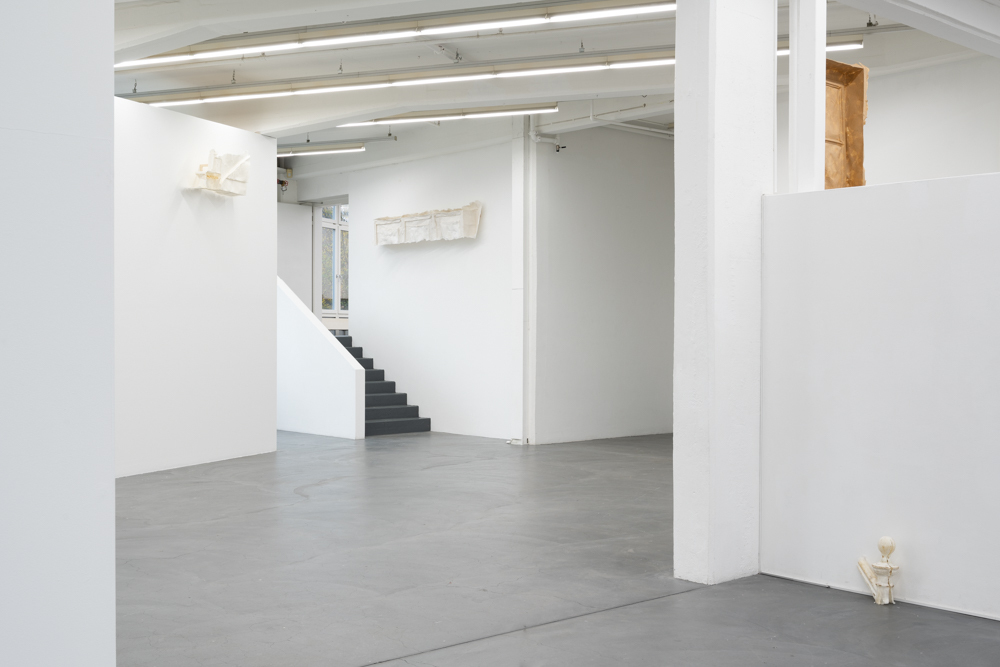
Negative molds of house corners, door frames, window ledges, and stair treads are hanging on the white walls; it makes you think of skin. Clinging here and there to the casts, we find remnants of building walls that Ester Alemayehu Hatle transfers into plaster and paper: flaking layers of paint, dust, plant residues. They are reminders of buildings that have been demolished or are about to be. Reminders as well of history and its narratives. They once served as a home for their residents, a retreat where they felt safe, lived, loved, argued, and made up again. A place that is entwined with many memories, both good and bad. Being asked to leave your own home is particularly upsetting when it is subject to demolition. You wish you could freeze time, preserve your memories, and take with you the feeling that this home gave you.
Ester Hatle has visited different buildings in Basel whose demolition or conversion she would like to remember. She has captured their last instants, the last moment just before their destruction, in her plaster and paper casts. She is interested in what gets lost following demolitions and the disappearance of what has been: materials, memories, emotions. As well as in how tenants are evicted by renovations, new developments, and the loss of places of remembrance in the city. Often, materials originally used to build a house also restrict its repurposing. What is torn down is irretrievably lost. Hatle counters this with memory, monument, and fragmented beauty.

The camera moves at a very slow pace and so does our gaze. The projections by artist duo Christine Camenisch and Johannes Vetsch employ the medium of video as moving light in space. It is rarely about a narrative. Their focus is on the deconstruction of space and allowing new spaces to emerge. The installation is permanent and ephemeral at once: the exhibition space, concrete and definite, suddenly becomes transient and provisional through the projection. As assured elements in the space, spatial lines seem to be superimposed. The place and the projection combine to create a tangible situation that viewers can enter and experience as a sense of confinement. Dark, stark beams, resembling bars, create a space within a space. This is a cage through which we can see the outside world but not access it. At the same time, what is on the other side, what is outside of it, seems only slightly tempting: a deserted factory area in Düsseldorf captured during lockdown. All windows and gates are shut. Construction sites are at a standstill. The sky is covered in clouds. The camera performs a slow-motion rotation, a 360-degree pan. Very slowly, it lets us revolve around ourselves. You almost feel like fast-forwarding to see if a door opens somewhere, a car drives by, or a person steps out of a building. But nothing stirs. The feeling of being locked up, which has become so strangely familiar to us, is conjured up again by Camenisch-Vetsch. The work serves as a reminder of a time when we could not go where we wanted—as well as a call to appreciate the freedom we have regained.
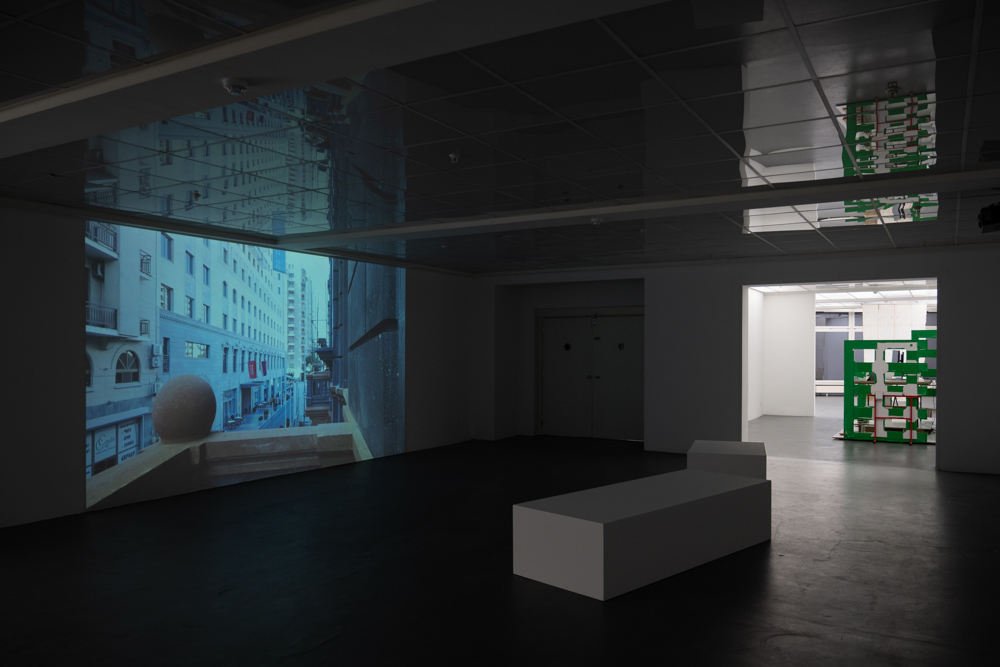
Scenes from a construction site: loads suspended from a crane, a concrete mixer driving by, a huge hole in the ground that has been excavated to make room for a new building. On the neighboring property, in the backyard of a house whose only remains are ruins, a woman waters her sparsely overgrown garden. She lives next to the construction, on a plot site where her house once stood. A trailer serves as her residence. “If I knew I was staying here for a long time, I would set everything up much better,” she says, “the walls, the windows...” No walls or windows can be seen; they have been replaced by plastic sheets and blankets. Lea Fröhlicher’s film Yerevan for the Time Being portrays all those whose lives are connected by the construction site—by destruction, construction, degradation, reconstruction. We meet the architect who wants to do something good for the neighborhood and revive it; the construction workers, almost all somehow related to each other, who have come from the countryside to find work in the city; the neighbors whose living room wall is two meters away from the pit of the construction site and who wake up at night to the noise of the crumbling masonry; the construction manager, who is confident about the project idea and proud of his work; and the choir director that is very sorry to see the former rehearsal rooms of his children’s choir collapse.
Lea Fröhlicher’s video works tell life stories—subtle, poetic, defiant in the face of life and its intricacies. With empathy and care, her recordings focus on people and their stories. The same can be said of the film Yerevan for the Time Being, which serenely probes and portrays the dreams, desires, and fears of the people surrounding a construction site in Armenia. Yerevan could be in many places.
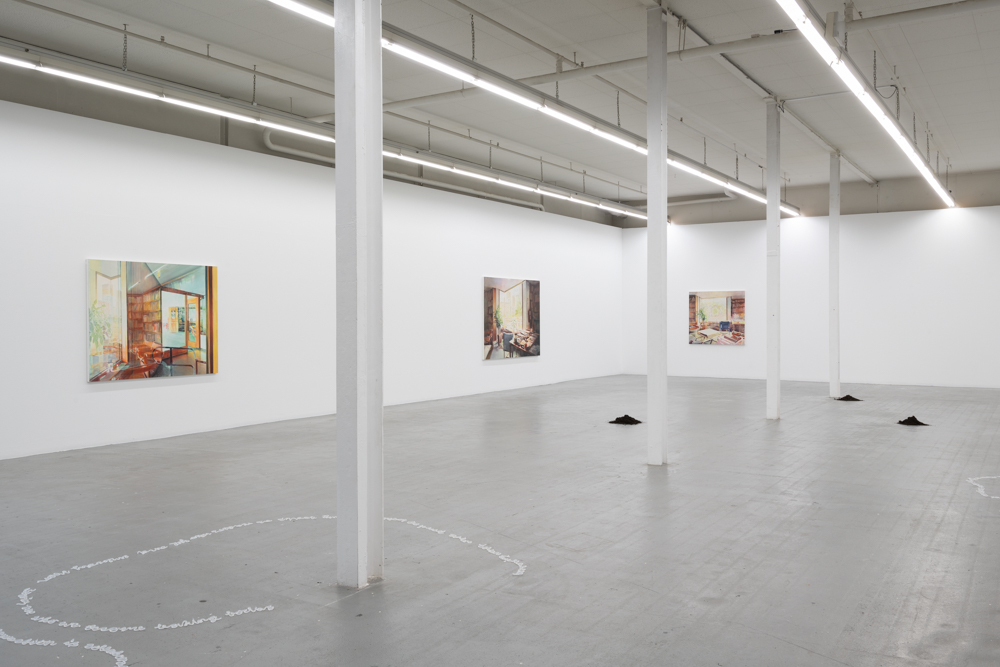
Deserted spaces flow into one another. Open doors invite us to walk through them, explore the interstices between these spaces, and lose ourselves. The boundaries between inside and outside dissolve; we are enveloped by the complexity of reflections and transparencies. It seems as though Anja Ganster has captured on canvas the memories from our dreams.
The question of where in the world the painted space is located becomes unimportant. It could be anywhere. But it is primarily within us. As viewers, we are concurrently protagonists who are absent from the paintings as motifs. Painted settings become spaces of identification that can trigger different memories, emotions, and moods in us. The anonymity in Anja Ganster’s spaces opens up painting to its viewers. The works are not meant to evoke specific reactions or feelings. The paintings’ openness is an offer from the artist to us, transforming spaces into experiences we can share.
The artist’s open nature becomes almost tangible in her works, as does her desire to travel, her wanderlust, as well as the need to always be on the move and create or provoke new states into being. Nothing is constant. Even light, which plays such a fundamental role in painting, is constantly changing as the Earth revolves around the sun. And ourselves along with it.
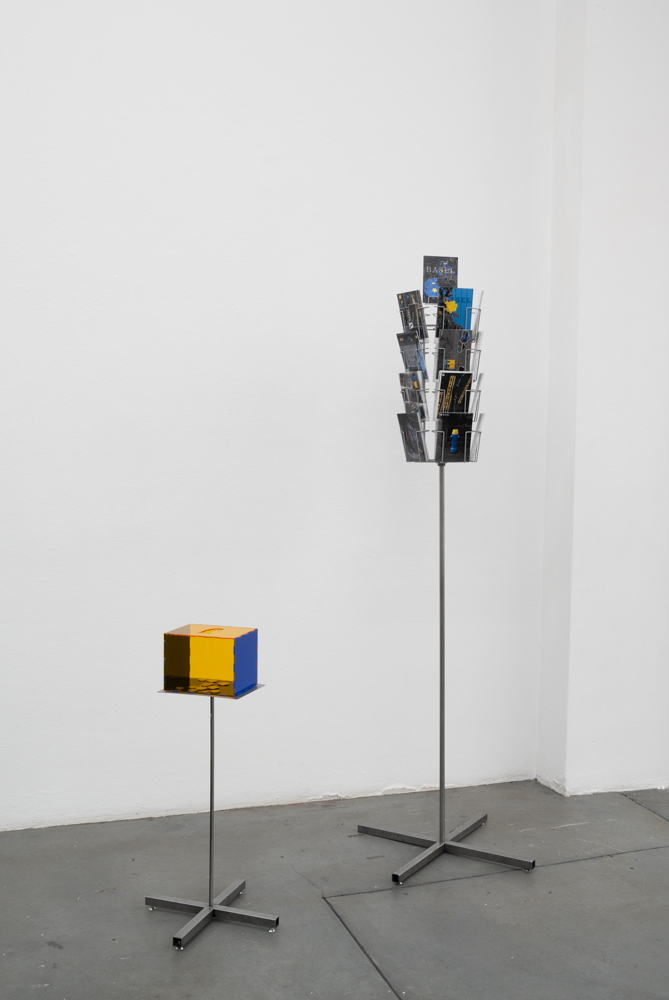
We send postcards to tell those at home about our vacation, share our experiences with them, and describe the nice weather, delicious food, and happy moments. They mostly feature imposing buildings, landmarks, or landscapes with beautiful views. Alyona Grekova’s postcards, however, convey a different feeling altogether. At the start of 2022, the artist from Kyiv fled Russia’s war of aggression on Ukraine to Basel, where she has been able to continue her art studies at the FHNW Academy of Art and Design. It is also a place where she can live in safety, although far from her home and family. But those who stayed at home are still living in a war that has been raging for many months. They are confronted with its consequences while she is safe.
Her postcards depict objects in the colors of the Ukrainian flag—blue and yellow. They were photographed in Basel, as part of a process where the artist explored the city as a new, temporary home, becoming familiar with it and documenting these encounters in images. Once discovered, the city seemed full of yellow and blue objects that echoed her home. They can now be sent in postcard format—as a call for empathy and solidarity, and a sign that we never forget those who are not with us. This is why the postcards at Kunsthaus Baselland are not only an object, but can also be purchased in exchange for a donation. The proceeds will go to volunteers in Ukraine, with whom the artist maintains close contact.
But how do you actually live far from home and family?
The second work by Alyona Grekova in the exhibition is also an echo, a memory of a dream. A delicate silver figure made from tin, resembling a fairy, is sitting on a swing on a chestnut leaf. The leaf is symbolic of Kyiv, which is also called the “city of chestnut trees.” The tin material is reminiscent of tin soldiers. The dream fairy therefore becomes the defender of good dreams. She appeared to the artist in her childhood dreams until she was 15 years old. Since the first mobilization of Russian troops in March 2021, the artist has been struggling with nightmares that are now finding their seamless progression in the events of the war. To counter this horror, Grekova turned a good dream into reality: with the fairy, she has brought to life the figure that gave her protection and security during her childhood. After all, home is also a place that surrounds us with stories and nice memories.
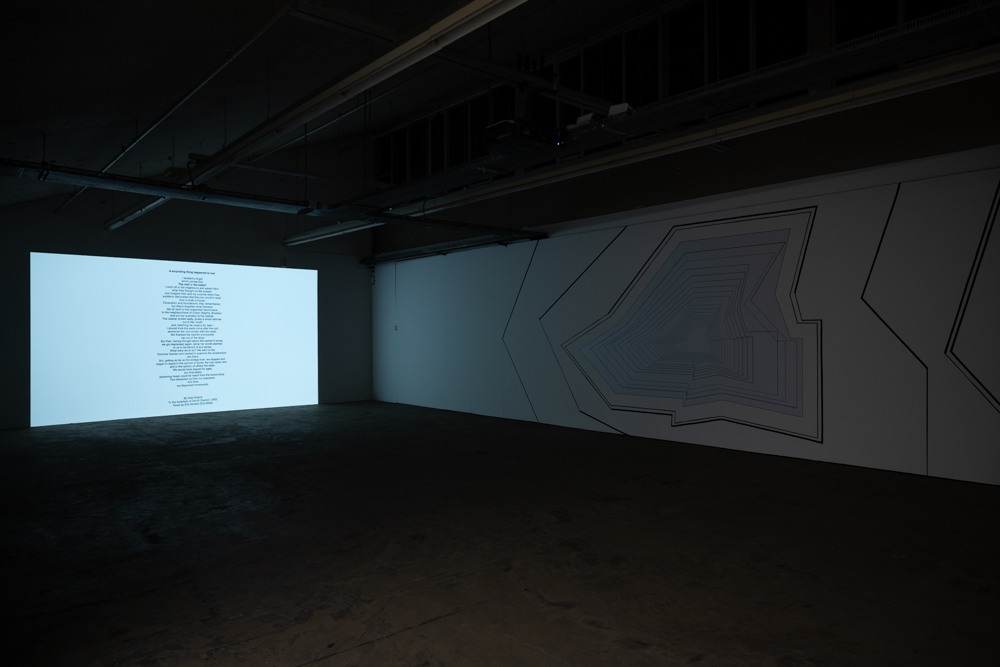
What comes first when building a house? The roof or the walls? Is the right order always evident? And is it the same in every country? Our knowledge seems to have gone astray. Maybe our neighbors know something about it? Bewilderment runs throughout the poem, which is read by the artist’s 14-year-old cousin of the artist Aida Kidane. In this single-channel video projection, it is only her voice that transforms the text into a delicate spatial sound meandering through the Kunsthaus architecture. The story unfolds as the narrators—or should we say protagonists—strive to find the correct sequence for building a house. You almost think that an argument is about to break out over something that, as the narrative progresses, no longer seems to be so straightforward.
On one side of the room, we find the video projection with the animated text, accompanied by the girl’s voice speaking in a Canadian accent. A high-contrast mural in black and white unfurls in the same space. This is a research project by the artist that is also closely connected to her origins and homeland: Casa M. A house in the city of Asmara, once under Italian occupation and now a UNESCO cultural heritage site. A house in a setting that has turned many things upside down. So what comes first when you build a house? The roof or the walls? In the end, the answer doesn’t seem that obvious anymore.

One room, two chairs, two people. A seemingly simple situation. But Lena Laguna Diel’s paintings are anything but simple. The partitioning alone shakes us up, and it seems as if the painting is rearranging itself before our eyes. Depending on which pictorial element we are focusing on at any given moment, it seems as though the canvases and color fields are constantly regrouping. The painting is made up of two canvases, which in turn are divided into several areas of color. The color fields stretch beyond the canvases’ edges, just as the motifs transgress the boundaries of the color fields and canvases.
The longer we look at the picture, the softer and more permeable the frontiers between motif and color, figuration and abstraction become. The bodies depicted are clearly recognizable as such, but they function just as much as pure, powerful color fields as the space surrounding them.
Diel’s approach to motif and color, and how these two elements combine, is also evident in the artist’s working process. Searching for and finding colors is just as important as the motif itself. Indeed, it is through composition and balancing hues that the atmosphere where subjects interact in the painting is created. Diel studies the composition and colors carefully, applying color schemes, experimenting with how the colors behave on the canvas and how their tonality changes once the paint dries. She keeps a record of how she arrived at each hue, creating a unique library or inventory of her colors, their production process, and how they interact with one another.
Diel’s works are distinctive for the interplay between the larger whole and the love and concern for detail. This becomes clear in the paintings through the relationship between the painterly work that is visible to us and the color studies that remain concealed from us. By juxtaposing the paintings with the recently produced ceramics, which are now increasingly present in the artist’s work, this leap into a different sense of proportion becomes tangible. The intimacy inherent in the works is palpable on both scales. And it is precisely through this quality that Diel is able to captivate and draw us into the spell of her works.
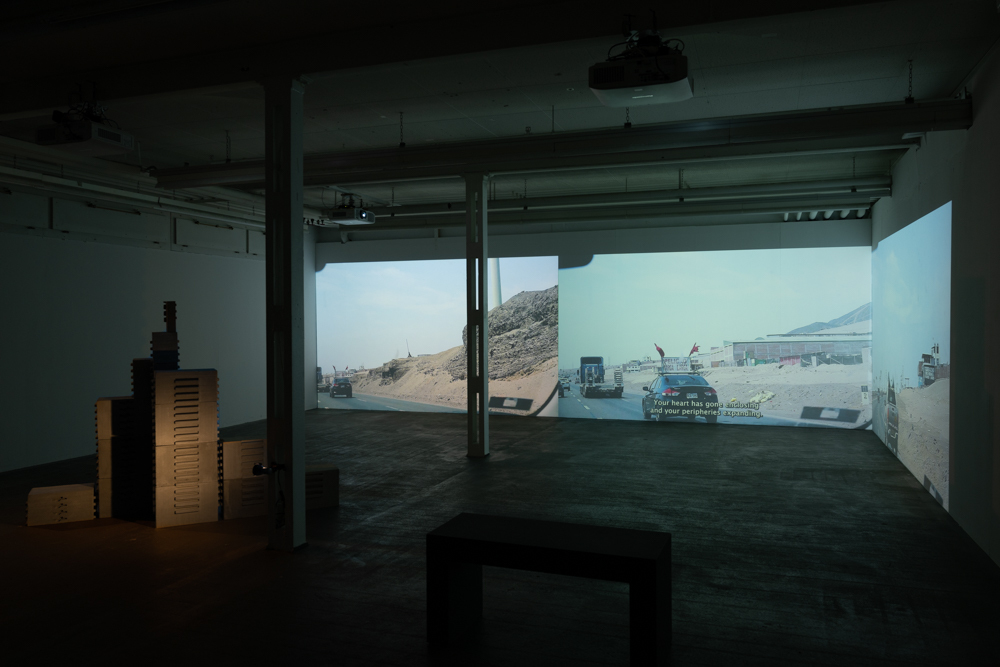
Individual concrete blocks can be seen in the space. Stacked on top of each other, they look like the start of a superstructure we have seen many times before. We feel like we have spotted them in many different places. They are actually fragments from an existing building: a modern high-rise in Lima, Peru, the artist’s native country. The tower overlooks the city, mighty and tall. But it is only an uninhabited skeleton—a project never completed, an empty promise, a shell of what it should have become. Josefina Leon Ausejo deconstructs her hometown tower from afar. Living in Basel, she surveys the building online, enters it, measures it, studies and sketches it. She deconstructs it and reworks individual pieces of information into concrete blocks that become emblematic of this abandoned, forgotten construction project.
The three-channel video projection, which ascends as a digital landscape behind the blocks, gives them both a panoramic view and a sense of place: scenes of a car ride, recorded from inside the vehicle. The forgotten tower is also situated on this route. The artist often drove along this path—it is part of her home. She is familiar with this landscape, and yet, from the moving car, she can never really look at it in depth. A distance lingers between the passengers and the surrounding area as it drifts by.
The feeling of only being able to experience something from a distance is inherent to both works. Leon left her hometown and migrated to Switzerland. The distance to one’s origins allows a new kind of reflection, a different perspective on oneself and all that surrounds you. It is only at a distance that we can see the big picture. The horizon remains invariable. It looms in the distance during the entire journey. It can be more or less visible at times, but it is always there. It is a constant that you can focus on if you feel dizzy while driving. This is precisely what Leon writes: “... When I am far, I miss it and it makes me dizzy when I don’t see it ...”
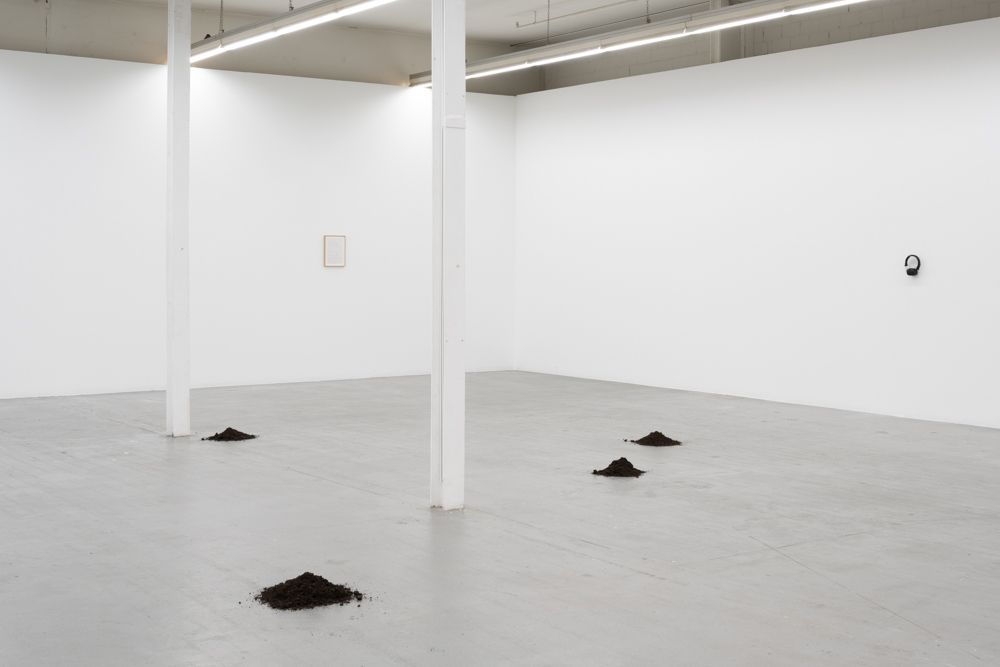
"Catapult, catcall, catfish, caterpillar..." An artificial sounding voice reads out concepts that are illustrated by pictures. They all have the word “cat” in common. These are followed by footage from a cat show. Several pedigree cats are sitting in their owners’ arms, being raised up, presented, examined, and judged. The assessment criteria and scores are pattered in the same emotionless voice as the cat vocabulary, which is repeatedly interspersed with scenes from the show.
Daniela Müller’s works chronicle humankind’s relationship to nature and how we need to control, domesticate, and optimize it. The artist reveals the absurdity behind this pet showcase in a way that is subtle and slightly tongue-in-cheek.
A similar theme can be found in the performance How to get a Mole out of a Garden, whose documentation can be seen at the Kunsthaus. It was inspired by online forums where garden enthusiasts exchange ideas on how to drive moles out of their private gardens. Suggestions are many and varied. They include burying a radio in the garden, spraying perfume, and poking bottles into the soil. And yet none of these ultimately work because of the mole itself, which remains invisible except for the molehills on the otherwise immaculately manicured lawn. This community of hobby gardeners—who are complete strangers in different circumstances—and all the moles ruining their lawns form a temporary, involuntary collective.
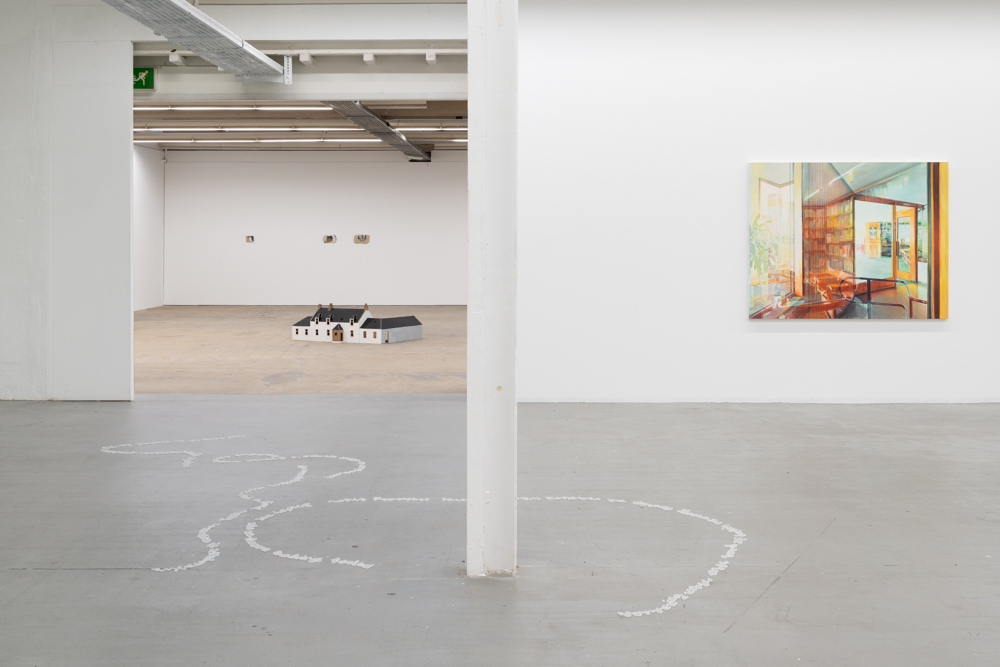
In the video work the garden became a boundless wideness—episode 1, we watch the artist Cheyenne Oswald lost in her thoughts as she explores a sumptuous and enchanted garden. Meanwhile, the artist’s grandmother, mother, and older sister discuss the way they see her profession, what they think an artist does, and what lies in store for Cheyenne Oswald and her artistic career. With these ideas of the future, we leave the garden and the artist behind in the film; there is a change of scenery. We (?) are sitting on a train, watching a beetle riding along on the outside of the window. The image of the artist in the garden, the focus on her and her abilities, talents, and hopes ends in a train ride into a future that is still uncertain. Being an artist is a decision that those around you may be more or less able to understand.
In the second work the artist is showing at the Kunsthaus for the Regionale, writing meanders across the floor, much like a snail’s trail. The semi-transparent sentence fragments in the work ode to the pace of slugs—variation 2 are made of silicone. This material can be used in bathrooms, for example, to seal joints and prevent moisture from seeping into gaps. In Oswald’s work, this elastic material goes from being a gap filler to becoming the main feature, forming full sentences conveying their own statements. Some of the phrases are excerpted from Kae Tempest’s book On Connection, which was written during the lockdown. Others are penned by Oswald, while also incorporating the quotes’ subject matter. Tempest’s book is about the human desire to connect with others and how this can be achieved through creativity and live art. By assimilating and reproducing this message, the silicone sets become symbols of the interpersonal connections we seek and need, and which we sometimes encounter by chance. At the same time, lockdowns removed speed from our daily lives, giving us time and the opportunity to intensify the connection with ourselves—an ode to slowness and poetry.
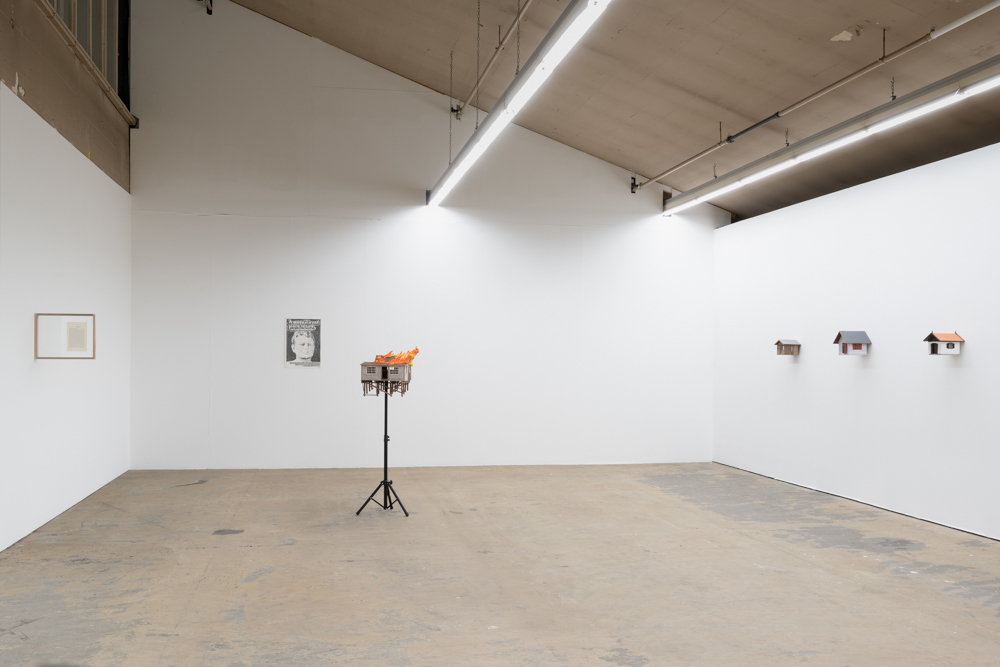
A small wooden hut balances on a pole in the room. It is an image of tranquility, but also of loneliness and seclusion. Who would want to live in such isolation?
To flee from civilization, withdraw to a lonely place to devote oneself entirely to creativity, be inspired by nature, and have the ability to concentrate on work without distraction: this is an ideal image that in the Western world is often associated with Henry David Thoreau and his book Walden.
For a long time, Joan Pallé has been artistically concerned with people who write. In order to be closer to themselves and their creativity, they have settled in what seems to be the middle of nowhere. Among them is Gustav Mahler, who wrote his compositions in the three cottages that are displayed as models on the wall. And there is also the English director and writer Derek Jarman, who lived in a black cottage on the coast of Kent. He created a garden around the house, which he lovingly cultivated and decorated with flotsam from the sea, stones, and other found objects. In 1990, Jarman immortalized this little oasis in his film The Garden.
People who draw on themselves to put something out into the world—such as by creating books, texts, or films—need a place where they can develop their creativity undisturbed and fully concentrated. Such a place of retreat and isolation can become a requirement for creativity. This contradiction can also be felt in Joan Pallé’s works. In his installations, he combines elements of critical thinking and popular culture, making one the mouthpiece of the other and showing the absurd balance that artists must always strike between these two worlds.
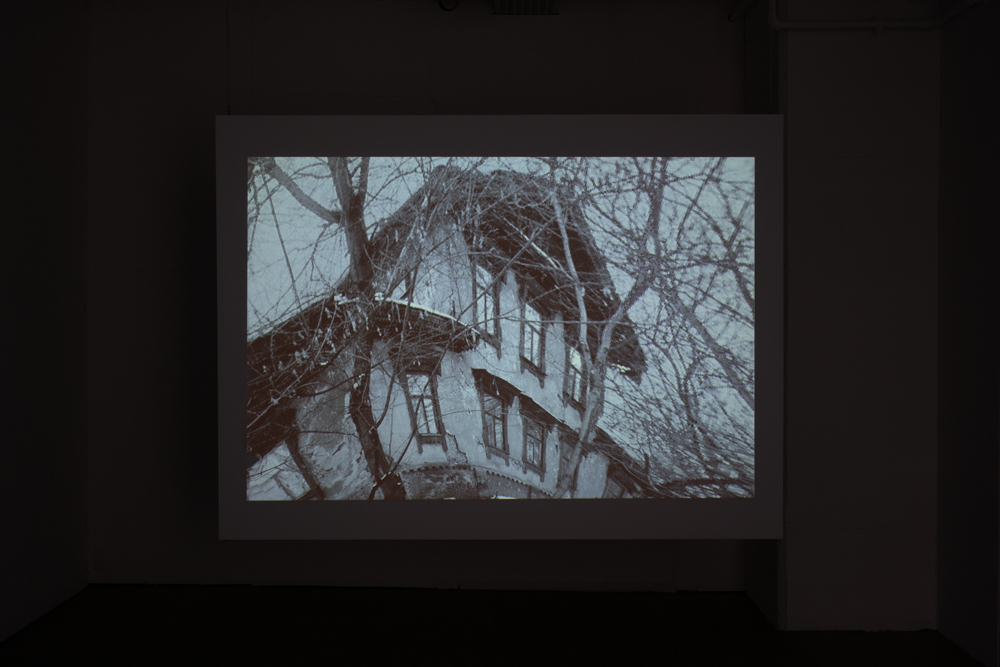
"Every day people of Ukraine lose something." This is the opening sentence of Nadiia Rohozhyna’s film Tatarka. One after the other, black-and-white shots of historical buildings in Ukraine appear on the screen. The artist’s gentle voice recounts how they have been destroyed by the Russian army on a daily basis. It is not only the country’s present that is being systematically annihilated, but also its past, its culture and history, and consequently the foundations for its sense of identity. This is a strategic move. And an inconceivable loss for all those affected. Tatarka began as a project by the artists’ group Three practices on realism, which Nadiia Rohozhyna co-founded with her husband, Oleksandr Gorbunov.
The artist herself fled to Basel only a few months ago in the wake of the war in Ukraine. There was a lot she had to leave behind; she had to take a great risk, start over. She has been able to continue her studies at the FHNW Academy of Art and Design and lives with a host family. When the war first broke out, she was active as a volunteer for food distribution. However, she soon realized that she wanted to make a different kind of contribution. As an artist, she sees it as her task to prevent culture from being destroyed and, at least in some small way, fill in the gaps that war is increasingly tearing in the country’s history each day.
The past is something we carry within us, just like the future. It shapes us, makes us who we are, and offers us security and assurance in the here and now. What we also need in the here and now is hope, and that is something we draw from the future. Even though it lies ahead of us, still unlived and uncertain, the future is capable of doing just that: giving us hope, driving us forward, and giving life meaning. Despite the horrific events the artist chronicles in her film, we have hope that the war will eventually come to an end and something new will thus begin.

The particular time and place in which a work is created play a central role in Nicolas Sarmiento’s oeuvre. Live Reduction was executed in 2022 for the Swiss Art Award at the Messe Basel exhibition center. The exhibition hall is not a traditional exhibition space, but rather a temporary location with small, swiftly installed booths for the featured artists. Events, directions, and requirements are constantly changing; the interior layout is flexible and can be adapted for all purposes. For Nicolas Sarmiento, it serves as a stopover, a place of transit for a brief one-week period—and an ideal place where to address precisely this issue.
Sarmiento’s work allows room for encounter and reaction. You can sense his curiosity for the environment, his openness to outside influences, and the flexibility this brings to his work. Live Reduction builds a space of its own and invites one to experience this space within a space anew. Two video works on flat screens are embedded in the installation.
The film _Traffic with reality_Like a 🦆 watching architectural digest II focuses on YouTube videos where celebrities take viewers on a tour of their luxurious homes. Sarmiento applies a filter over the footage, darkening the images and dimming the opulence, pomp, and luxury. Instead of sound, the work is provided with subtitles.
In the video floor mode, shots of hiking trails and landscapes in and around Lugano interweave with images from Basel and Baselland. In other words, these are images taken from the artist’s commute and place of work. Sometimes the subtitles seem to fit the images, sometimes they don’t. They are a parallel narrative thread that playfully approximates the film footage and then departs from it again. When the video was installed alongside other works in the exhibition hall, it was overlaid by the sound of other people’s sound and video pieces. Other works’ soundtracks and surrounding noises blended together, in a way re-scoring Sarmiento’s work on behalf of the artist.
Nicolas Sarmiento’s works can always be read in new ways depending on what comes, goes, or stays. This means that in the Kunsthaus, too, voices, sounds, or even visitors’ movements will be superimposed on the work as additional layers, opening up a new dimension in so doing.

Caresser l’histoire is the title of the work by France-based artist Jade Tang. It focuses on the vegetation found in archaeological excavation sites. A whole display system sprawls across the entire space: white, earthy fabric panels are hanging in the room and test tubes filled with burnt seeds can be seen lined up next to each other. For this work, the artist turned her attention to three construction sites in Strasbourg, where two specialized fields overlapped: urban development and rescue archaeology. She visited the construction sites almost daily and encountered scientists from a wide range of disciplines: archaeology, carpology (study of seeds and fruits), and even dendrochronology (dating and origin of wood). The highly concentrated gestures that archaeologists perform during their work require fine motor skills and are very different from what usually happens on an urban construction site. Almost tenderly, scientists repeatedly sweep the same spot with different brushes, removing one fine layer of sand after another to reveal what has been lying hidden for centuries. The work owes its title—Caresser l’histoire, to stroke history—to this fondling action as well as the great respect shown towards a remote past in order to understand the present. On the construction site, different subject areas, interests, and goals converge, to which Tang added a facet of her own from an artist’s perspective.
The extent to which these encounters and exchanges of knowledge inspire her and drive her work is evident in a number of her creations. She is able to allow experiments, different techniques, and materials to tell one and the same story. It is that of history and the overlapping of past and present, which also informs her works and artistic creations still to come.
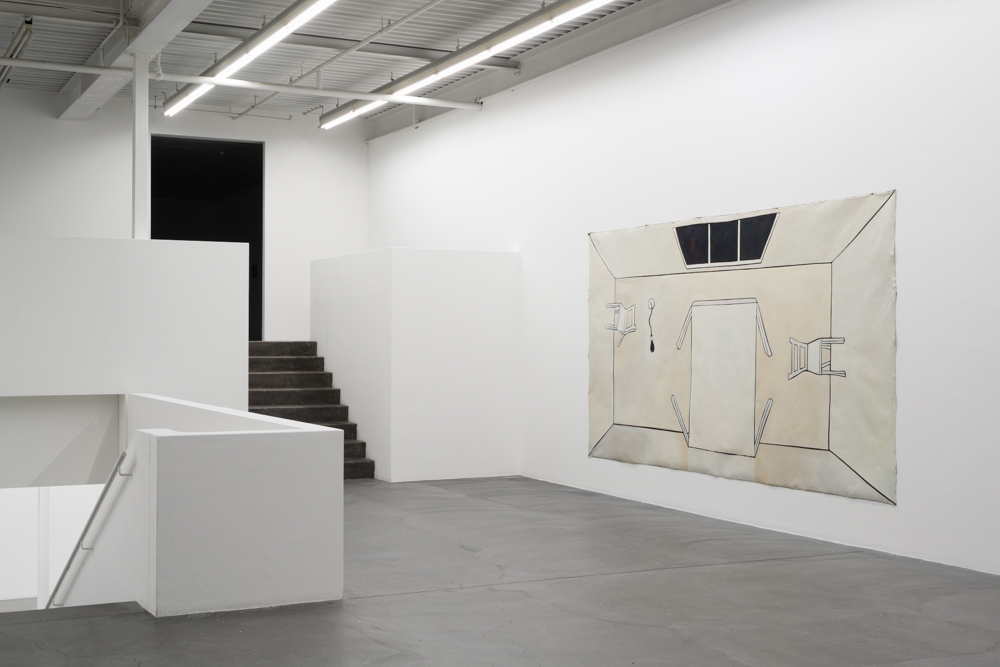
There are three rooms. They are so large that they occupy the exhibition space and overlay it like skin. They have been sparsely furnished: a few chairs and a table. The actual space is defined by a few lines; the spatial illusion begins to dissolve if we look at it long enough. The floor becomes a wall, the window is on the ceiling, the room becomes a surface and this surface becomes the room—until all sense of up and down, left and right vanishes altogether. It seems that there is nowhere left to hold on to. An uneasy feeling starts to spread. In each room, there is a naked light bulb hanging from the ceiling. Or from the wall? Is the lamp floating in the room? The settings are bathed in harsh light, although it doesn't come from the light bulbs. They seem to absorb the brightness rather than emit it. There is no light coming from outside either. All we see through the windows is flickering darkness, juxtaposed with a white hue that begins to vibrate the longer we look at it. Surfaces shimmer in many different shades of color, which in some places seem to form an aura around the objects depicted. On closer inspection, the black outlines delineating the chairs and tables are not painted strokes. Rather, they reveal the underlying black primer, the gap between surfaces. The paintings are based on small ink drawings; in the course of translation, a line in the drawing becomes a gap in the painting and dimensions expand to take up the room. These pictures exude a wild force. Particularly as a result of the decision of the artist Inka ter Haar to install them without frames, the effect on the viewer is even more direct and immediate. The painted architecture dovetails and connects with the real one to form a new totality.
All artist texts by Meret Glausen
Selected press coverage
Project partners

